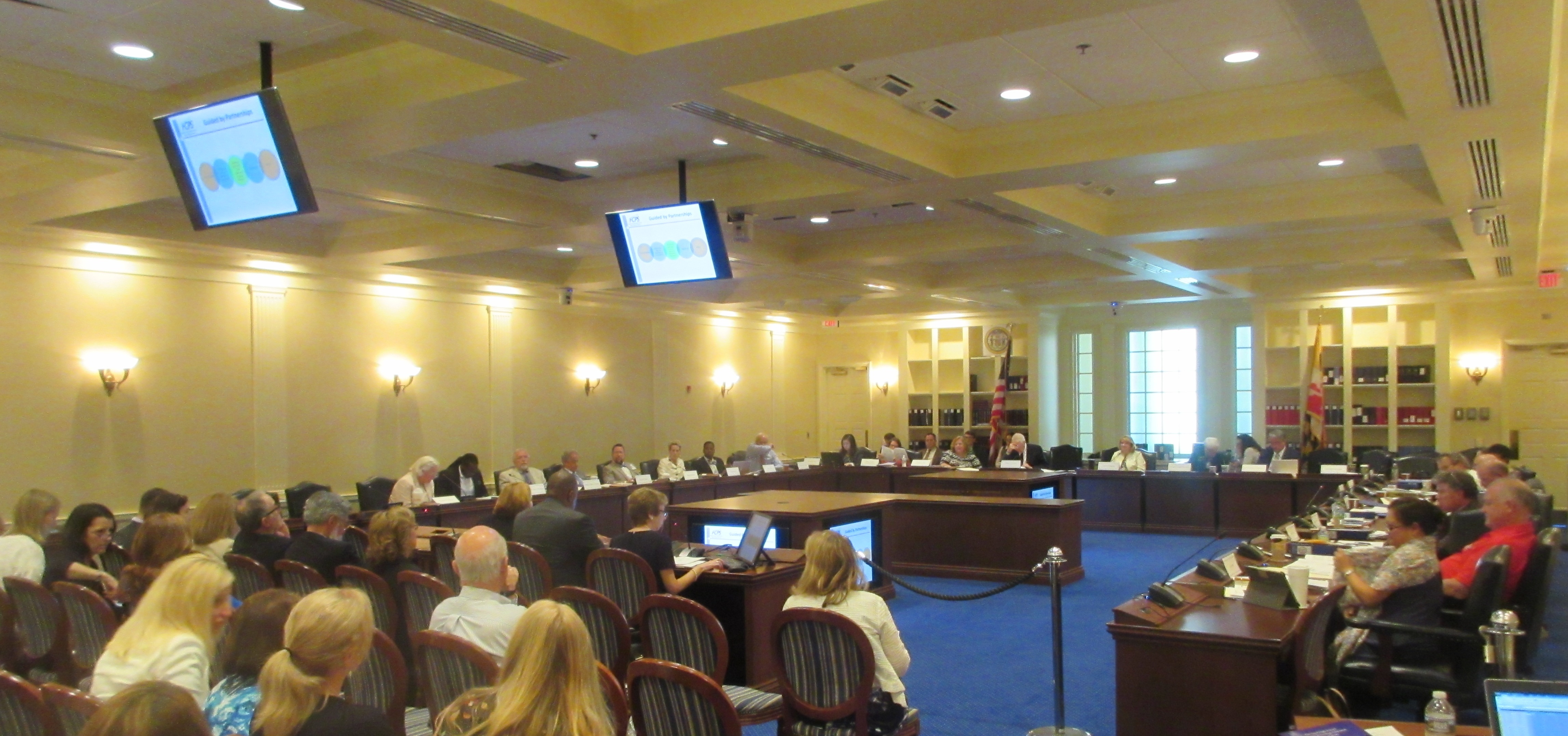By Len Lazarick
Maryland often prides itself on how good its schools are and how much it spends on them. But the Kirwan Commission studying the state’s school funding and how it spends the money was told on Wednesday that Maryland actually lags behind several states with better test scores — Massachusetts, New Jersey and New Hampshire.
On the other hand, compared to countries with top-performing students, U.S. schools spend far more per pupil.
The conclusion, according to Marc Tucker of the National Center on Education and the Economy, is that “money matters but how it is spent matters greatly.”
Tucker’s group is the lead consultant for the Maryland Commission on Innovation and Excellence in Education, chaired by former University System Chancellor Brit Kirwan.
Key recommendations
Tucker made several key recommendations to the commission (pages 75-80). They included:
- Adding funds for school districts with concentrated poverty;
- Forcing school districts to spend more on high-risk students;
- Changing the way local school district wealth is calculated;
- Eliminating the Geographic Cost of Education Index that provides more funding for higher-cost counties;
- Providing more high quality teachers to high needs schools;
- Providing incentives to teachers to teach in high-need and rural schools including pay bonuses and advancement on a career ladder;
The last recommendation brought a strong reaction from commission member David Helfman, executive director of the Maryland State Education Association, the teachers union.
“I don’t believe the proper starting point is incentive pay for teachers,” Helfman said. Research shows that “working conditions in these schools is going to make the difference,” such as better support services and more planning time, rather than big bonuses for teaching there.
The commissioners also discussed changing funding formulas to focus on how much individual schools get rather than lump sum allocations to school districts.
Other education consultants have already told the commission that Maryland and its subdivisions ought to spend $2.9 billion more on public schools.
The commission is only just beginning to grapple with funding formulas, but since it began meeting last September, it has heard from many different education experts about how state schools can improve how students are taught and how they learn.
How Maryland ranks
According to Tucker’s figures, Maryland’s median incomes are the highest in the nation, but school spending is the 10th highest among the states and 16th highest when adjusted for regional cost differences. Maryland’s foundation grant of $6,964 in fiscal 2017 — the basic state funding level for every student — is lower than the foundation grant level in Massachusetts or New Jersey.
Maryland has often touted its ranking as having the best schools in the nation four years in a row from 2008 to 2012 based on the state report cards by Bethesda-based Education Week magazine. But consistently it ranked behind Massachusetts and New Jersey on student scores on national and international tests, which only counted for one-sixth of the grade on the magazine’s report card.
“Maryland does not do very well on funding equity,” Tucker said. The state spends 4.9% less on poor school districts than wealthy ones when state and local spending are combined, lower than the three benchmark states, and the 16th most regressive among all states.
When federal funds are added, Maryland spends only 1.5% more per pupil on poor districts than wealthy ones.
“There are 41 states that do better than that,” Tucker said. Localities do not fully fund their share of the funding formulas that provide more for at-risk and special education students, and Maryland’s best teachers are not in its worst performing schools, which is the pattern in top-performing countries.
Building blocks
Tucker’s reports to the commission have focused less on funding than on how top performing schools in the U.S. and in selected countries achieve their results.
These building blocks include:
- recruiting the best and brightest high school students to become teachers;
- training them at the best research universities;
- subsidizing their education in exchange for a commitment to teaching;
- emphasizing apprenticeships in teaching in addition to classroom learning;
- creating career ladders for master teachers;
- specializing in subject matter fields;
- and providing for more planning and collaboration time for teaching teams.
Schools in countries with top performing students often have larger class sizes than in the U.S. but better teaching methods that allow for individualized instruction.
Achievement gap
A sore point in Maryland’s students scores is the achievement gap between schools with high percentages of poor African American and Latino students and other schools.
One commission member pointed out that Massachusetts, New Jersey and New Hampshire all have many small school districts, compared to Maryland’s 24 larger county-based systems. No one mentioned that all three states also have a much lower percentage of African American students. Massachusetts and New Jersey are also among the few states that have taxes as high or higher than Maryland.
Tucker said that schools in top-performing countries put “more teachers in schools serving vulnerable students,” a category often gauged by the amount of education of the mother of the child. Career ladder policies also “incentivize their best teachers and most capable principals to serve in schools serving vulnerable students.”
They also provide financial incentives for teachers to work in high need schools.







Ah !
The annual pleading for more funds for mediocre schools and an “public education racket”…
More money is not the answer…
Homeschoolers and private schools produce better students with less money per student…
There are so many things wrong with our current education system and the biggest is that people are basing their assumptions on USELESS test scores. How can anyone gain any insight into students based on a score of 1-5 on tests in only ELA and Math? The only thing the tests consistently point to is that wealthier areas have higher test scores than areas of poverty. I’m guessing little Jimmy isn’t really interested in reading and math when he has had no food. It all comes down to ‘bell curved’ scores (1-5) in ELA and math (and who decides the cut scores for that bell curve?). What about the students who are gifted in art or music? What about the kids who excel in science or history? It is wrong to compare students AND teachers based on these ridiculous tests that promote the awful Common Core. Get rid of the tests, get rid of common core, let teachers develop age appropriate curriculum and allow them the autonomy to teach that rich and robust curriculum. I’m tired of hearing “rigor” and “college and career ready”. The idea of a public education is to turn out well rounded, democratic individuals ready for life, not meat widgets for the workforce. Get the free market reforms out of public education.